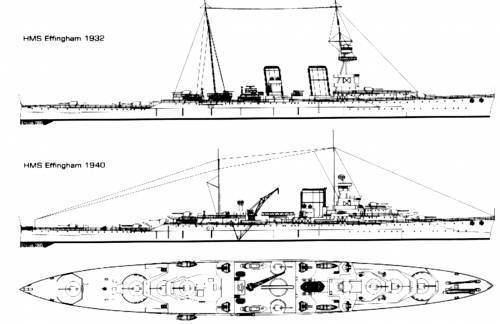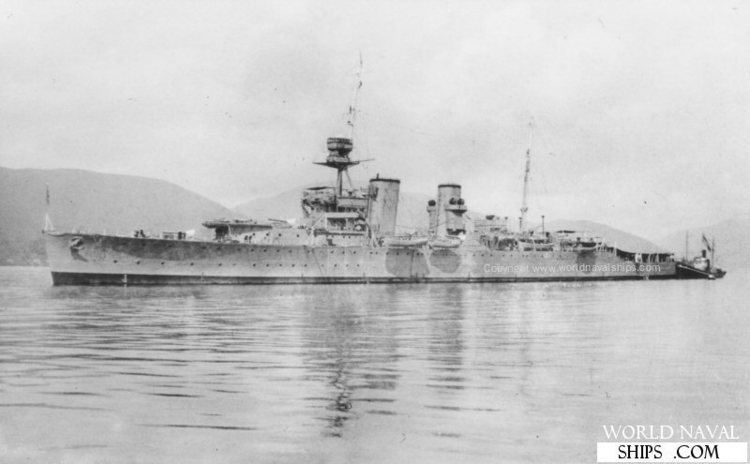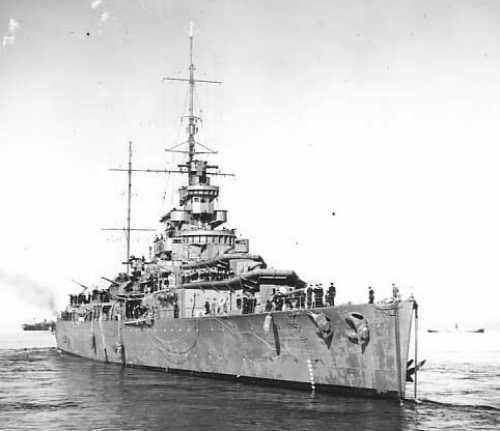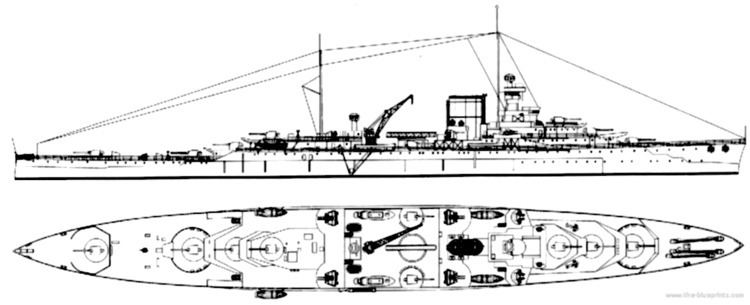Name HMS Effingham Laid down 6 April 1917 Identification Pennant number D98 Launched 8 June 1921 Builder HMNB Portsmouth | Ordered December 1915 Commissioned 2 July 1925 Construction started 6 April 1917 Length 184 m | |
 | ||
Namesake Lord Howard of Effingham | ||
HMS Effingham was a Hawkins-class heavy cruiser of the Royal Navy. She was commissioned at Portsmouth in 1925, having had her construction halted for several years following the end of the First World War in 1918. She was named after Lord Howard of Effingham, one of the leaders of the fleet that defeated the Spanish Armada in 1587. Completed in 1925, the vessel saw action during the Second World War and was escorting a convoy to Norway in 1940 when she ran aground. The crew was evacuated and the cruiser destroyed by a torpedo from an accompanying destroyer.
Contents
Design

Effingham had a displacement of 12,190 tons, was 605 feet (184 m) long with a 65-foot (20 m) beam, and carried a complement of 690 officers and men. As originally designed she carried seven 7.5-inch guns, along with anti-aircraft (AA) weaponry and six torpedo tubes. After the end of the First World War her construction was a low priority and she was the last of the class to be completed, in 1925.
Early career

Effingham served as flagship of the Far Eastern Squadron in the East Indies between 1925 and 1932, before being placed as the flagship for the reserves on her return. She is mentioned in Evelyn Waugh's short book about the 1930 coronation of Haile Selassie in Abyssinia as having provided her Royal Marine band for the occasion.
Modernisation

In 1937–38 Effingham was given an extensive modernization which radically changed her appearance. Her boilers were reduced from 12 to 10, as a result of which she was given a single vertical funnel in place of the two raked ones, and vertical masts. Her main armament was changed to nine 6-inch guns in single mountings, all along the centre line. The forwardmost three of these were superfiring, necessitating an extra superstructure deck built in front of the bridge, which was itself rebuilt. She also received four 4-inch AA guns in single mountings (in 1939 these were removed and replaced by two twin mountings), the torpedo tubes were removed, and she received a crane for handling aircraft, though the proposed aircraft catapult was not fitted and she never actually carried an aircraft. Similar modernisations had been planned for her sisters Frobisher and Hawkins, but were postponed and then cancelled due to the outbreak of the Second World War.
Post-modernisation service

After she recommissioned Effingham served on the North America and West Indies station. Following the outbreak of the Second World War Effingham patrolled the Northern Atlantic, in the Iceland region and was flagship of the Northern Patrol Force and transported £2 million in gold reserves to Halifax, Nova Scotia in Canada. She hunted German surface raiders on her return, and this led her to be in Norwegian waters during the Norwegian Campaign. During this period, she was attacked by a submarine but not hit, continuing to bombard German positions in the hills around Narvik until May, when she escorted a troop convoy to Bodø.

On 18 May 1940 Effingham was lost while engaged on transport escort duties. Traveling at 23 knots (43 km/h), outside the Norwegian Leads to minimise the risk of air attack, she was only one hour away from her destination when she struck a large rock in the area of Bodø (Bliksvær), in the Faxsen Shoal, near Bodø (20 minutes from the destination), between Bliksvær and Terra islands. The rock was well known and marked on the ship's charts, but when the navigator had drawn the ship's passage onto the map, his pencil mark had obscured the obstacle directly in the ship's path. No one was killed in the wreck, which was destroyed with a torpedo from the accompanying destroyer HMS Matabele on 21 May after all her crucial papers and equipment had been removed. The ship rolled onto her side, leaving much of her flank above water and the masts and funnel level with the surface. The wreck was dismantled by Høvding Skipsopphugging after 1945, only a few plates and components now being left on the sea bed.
During her brief war service, she was awarded the battle honours Atlantic 1939–1940 and Norway 1940. She is the only ship of the Royal Navy to have borne the name Effingham, but it was bestowed upon a shore installation for the training of naval special forces in 1943.
